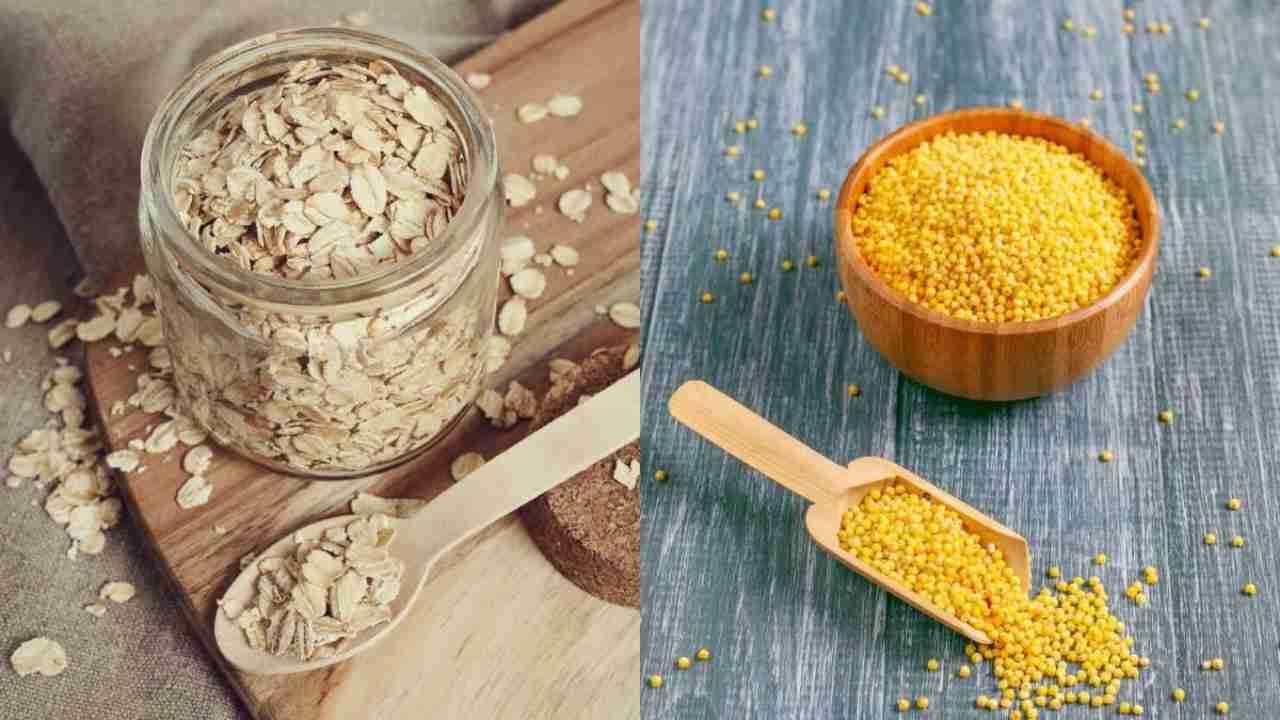In the realm of healthy eating, grains often take center stage. With the growing interest in diverse grains beyond the traditional wheat and rice, oats and millets have emerged as popular contenders. Both are celebrated for their nutritional profiles and versatile culinary uses. But when it comes down to choosing between oats and millets, which one holds the crown for being the more nutritious choice? Let’s delve deeper into their characteristics to find out.

Oats: The Breakfast Champion
Oats, often referred to as the “Breakfast Champion,” have rightfully earned their place as a beloved morning meal option. Beyond their comforting taste and versatility in the kitchen, oats are packed with a plethora of essential nutrients that contribute to overall health and well-being.
High Soluble Fiber Content
One of the most remarkable features of oats is their exceptionally high soluble fiber content, predominantly in the form of beta-glucan. This soluble fiber has garnered attention for its remarkable heart-healthy properties. Studies have shown that beta-glucan can effectively lower cholesterol levels by reducing the absorption of cholesterol in the bloodstream, thereby promoting cardiovascular health. Moreover, the soluble fiber in oats plays a crucial role in stabilizing blood sugar levels, making them an ideal choice for individuals managing diabetes or those seeking weight management.
Rich in Essential Nutrients
In addition to their fiber content, oats are a veritable powerhouse of essential nutrients. They serve as a good source of manganese, phosphorus, magnesium, and iron, all of which are vital minerals that play diverse roles in maintaining optimal health. Manganese contributes to bone formation and wound healing, phosphorus supports energy production and bone health, magnesium aids in muscle and nerve function, and iron is essential for oxygen transport in the blood. By incorporating oats into your diet, you’re providing your body with a nutrient-rich boost that supports overall well-being.
Antioxidant Properties
Oats also contain a variety of antioxidants, including avenanthramides, which have garnered significant attention for their potent anti-inflammatory properties. These antioxidants help combat oxidative stress in the body, reduce inflammation, and may contribute to lowering the risk of chronic diseases such as heart disease, cancer, and diabetes. Incorporating oats into your diet can thus serve as a proactive measure in promoting long-term health and longevity.
Culinary Versatility
Beyond their nutritional benefits, oats offer a wide array of culinary possibilities. From classic oatmeal and granola to innovative savory dishes like oat-based burgers and meat substitutes, oats can be incorporated into virtually any meal of the day. Their mild flavor and ability to absorb other flavors make them a favorite ingredient in both sweet and savory recipes, catering to a diverse range of palates and culinary preferences.
Millets: The Ancient Grains
Millets, often hailed as the “Ancient Grains,” have stood the test of time, cultivated for thousands of years and cherished for their exceptional nutritional benefits and sustainability. This resurgence in popularity is not without merit, as millets offer a treasure trove of health-promoting properties and culinary versatility that appeal to modern-day health-conscious consumers.
Gluten-Free Nature and Digestive Health
One of the most significant advantages of millets is their gluten-free nature, making them an invaluable option for individuals with celiac disease or gluten sensitivities. This inherent gluten-free characteristic sets millets apart from many other grains, offering a safe and nutritious alternative for those with dietary restrictions. Furthermore, millets are rich in dietary fiber, providing both soluble and insoluble fibers that support digestive health and promote gut microbiome diversity. These fibers aid in regular bowel movements, prevent constipation, and contribute to a healthy gut environment.
Low Glycemic Index and Blood Sugar Regulation
Millets boast a low glycemic index, meaning they cause a slower and more gradual rise in blood sugar levels compared to refined grains. This property is particularly beneficial for individuals managing diabetes or those seeking to maintain stable blood sugar levels. By consuming millets, individuals can enjoy sustained energy levels without experiencing spikes and crashes in blood sugar, thereby supporting overall health and well-being.
Rich Source of Essential Nutrients
Millets are a nutritional powerhouse, packed with essential vitamins, minerals, and antioxidants that promote optimal health. They are abundant in magnesium, phosphorus, iron, and calcium, all of which play critical roles in various bodily functions such as bone health, energy metabolism, and immune system function. Additionally, millets contain a diverse array of antioxidants, including polyphenols and flavonoids, which possess potent anti-inflammatory and anti-cancer properties. By incorporating millets into your diet, you’re providing your body with a potent arsenal of nutrients that support overall health and disease prevention.
High Protein Content and Culinary Versatility
One of the standout features of millets is their impressive protein content, making them an excellent plant-based protein source for vegetarians and vegans. This high protein content not only supports muscle growth and repair but also helps promote satiety and weight management. Moreover, millets offer a diverse range of culinary options, from comforting porridges and hearty pilafs to gluten-free flatbreads and baked goods. Their nutty flavor and hearty texture add depth and complexity to dishes, making them a popular choice in traditional cuisines around the world.
In conclusion, millets emerge as nutritional powerhouses with a rich history and a promising future in modern diets. Their gluten-free nature, low glycemic index, abundance of essential nutrients, and culinary versatility make them a valuable addition to any balanced diet. Whether you’re looking to support digestive health, regulate blood sugar levels, or simply explore new flavors and textures in your meals, millets offer a delicious and nutritious solution that honors both tradition and innovation.
Conclusion: Choosing the Right Grain for You
When it comes to choosing between oats and millets, both grains offer impressive nutritional profiles and versatile culinary uses. Oats stand out for their high soluble fiber content and heart-healthy properties, making them an excellent choice for individuals looking to improve cholesterol levels and manage blood sugar. On the other hand, millets boast a gluten-free nature, low glycemic index, and high protein content, making them a preferred option for those with gluten sensitivities or seeking plant-based protein sources.
Ultimately, the choice between oats and millets boils down to personal preference, dietary requirements, and culinary preferences. Incorporating a variety of grains into your diet ensures you reap the diverse nutritional benefits they offer while adding excitement and flavor to your meals. So whether you’re enjoying a comforting bowl of oatmeal or savoring a flavorful millet pilaf, rest assured that both grains can play a nutritious role in your journey to healthier eating.
FAQs about Oats vs Millets: Which is a Nutritious Choice?
- What are oats and millets?
- Oats and millets are both grains that are celebrated for their nutritional profiles and versatile culinary uses. Oats belong to the genus Avena, while millets encompass a diverse group of small-seeded grasses including varieties like pearl millet, finger millet, sorghum, and foxtail millet.
- Are oats and millets gluten-free?
- Oats are not inherently gluten-free but can be certified gluten-free if they are processed in facilities that avoid cross-contamination with gluten-containing grains. Millets, on the other hand, are naturally gluten-free, making them a suitable choice for individuals with celiac disease or gluten sensitivity.
- Which grain is higher in fiber, oats, or millets?
- Both oats and millets are rich in fiber, but oats are particularly renowned for their high soluble fiber content, especially beta-glucan. However, millets also provide a good amount of dietary fiber, contributing to digestive health and satiety.
- Are oats or millets better for heart health?
- Oats are often considered superior for heart health due to their high soluble fiber content, which can help lower cholesterol levels and reduce the risk of cardiovascular disease. However, millets also offer heart-healthy benefits, including their low glycemic index and abundance of antioxidants.
- Which grain is more suitable for managing diabetes?
- Both oats and millets have a low glycemic index, meaning they cause a slower rise in blood sugar levels compared to refined grains. Therefore, both grains can be beneficial for managing diabetes and maintaining stable blood sugar levels.
- Do oats or millets contain more protein?
- Millets generally contain more protein than oats, making them an excellent plant-based protein source for vegetarians and vegans. However, oats still provide a moderate amount of protein and can contribute to meeting daily protein requirements.
- Which grain is higher in essential minerals like iron and magnesium?
- Both oats and millets are rich sources of essential minerals such as iron and magnesium. However, the exact mineral content may vary depending on the variety of oats or millets and their processing methods.
- Can oats or millets help with weight management?
- Oats and millets are both nutrient-dense grains that can contribute to weight management when incorporated into a balanced diet. Their high fiber content promotes satiety and helps regulate appetite, making them valuable additions to a weight loss or maintenance plan.
- Are oats or millets suitable for gluten-sensitive individuals?
- While oats themselves do not contain gluten, they are often processed in facilities that handle gluten-containing grains, leading to potential cross-contamination. Therefore, individuals with celiac disease or gluten sensitivity should opt for certified gluten-free oats. Millets, on the other hand, are naturally gluten-free and safe for consumption by gluten-sensitive individuals.
- Can oats or millets be consumed by people with nut allergies?
- Oats and millets are both naturally free of nuts and are safe for consumption by individuals with nut allergies.
- Are oats or millets suitable for babies and toddlers?
- Both oats and millets can be introduced into a baby’s diet once they are ready for solid foods, typically around 6 months of age. However, it’s essential to ensure that the grains are prepared in a suitable consistency and texture for the child’s age and developmental stage.
- Which grain is more environmentally sustainable?
- Millets are often considered more environmentally sustainable than oats due to their ability to thrive in diverse agroecological conditions, requiring less water and fertilizer inputs compared to some other grains. Additionally, millets are resilient crops that can withstand adverse weather conditions, making them a valuable option for sustainable agriculture.
- Are oats or millets suitable for people following a vegan diet?
- Both oats and millets are suitable for people following a vegan diet as they are plant-based sources of nutrients, including protein, vitamins, and minerals.
- Can oats or millets be consumed raw?
- While oats are typically consumed after being cooked or processed, some people enjoy soaking raw oats in liquid overnight to create a cold oatmeal or “overnight oats” dish. Millets can also be consumed raw, such as in sprouted form or ground into flour for raw recipes like energy balls or bars.
- Which grain is more commonly used in traditional cuisines?
- Millets are more commonly used in traditional cuisines, particularly in regions where they have been cultivated for centuries, such as parts of Africa, Asia, and India. Oats, on the other hand, are often associated with Western cuisines but have gained popularity worldwide in recent years.
- Can oats or millets be used as a substitute for rice or other grains in recipes?
- Yes, both oats and millets can be used as substitutes for rice or other grains in recipes such as pilafs, salads, and grain bowls. They can also be ground into flour and used in baking recipes like bread, muffins, and pancakes.
- Are oats or millets suitable for individuals with high cholesterol levels?
- Oats are particularly beneficial for individuals with high cholesterol levels due to their high soluble fiber content, which can help lower LDL (bad) cholesterol levels. However, incorporating millets into the diet can also contribute to overall heart health and may help lower cholesterol levels.
- Which grain is easier to digest, oats, or millets?
- Both oats and millets are generally well-tolerated by most people and are considered easy to digest. However, individual tolerance may vary, and some people may find one grain more digestible than the other based on their personal preferences and digestive health.
- Can oats or millets be included in a gluten-free diet?
- Yes, both oats and millets are suitable for inclusion in a gluten-free diet. However, it’s essential to ensure that oats are certified gluten-free to avoid potential cross-contamination with gluten-containing grains during processing.
- Which grain is more readily available in supermarkets?
- Oats are typically more readily available in supermarkets, as they have gained widespread popularity and are commonly consumed worldwide. However, millets can also be found in many health food stores, specialty markets, and online retailers, especially in regions where they are popular in traditional cuisines.
Register for My Upcoming Masterclass HERE
See You in the Live Masterclass
Sunil Chaudhary stands as a preeminent global Leading digital coach, boasting a diverse clientele hailing from over 50 nations. Renowned for his prowess as an exemplary SEO expert, business automation coach, and landing page authority, Chaudhary also holds the distinction of being esteemed as the finest business coach in India. Beyond technical domains, he imparts invaluable insights into mindset, success, and life skills, thus encompassing a holistic approach to mentorship.
Join FREE Courses HERE
Know The Author:
 Sunil Chaudhary aka Suniltams Guruji is India’s Leading Digital Coach. He provides complete Digital Skill Development Coaching with great support. Sunil has trained more than 25000 students and helped more than 1100 businesses so far. Sunil is a well-known face across the world for Digital Coaching.
Sunil Chaudhary aka Suniltams Guruji is India’s Leading Digital Coach. He provides complete Digital Skill Development Coaching with great support. Sunil has trained more than 25000 students and helped more than 1100 businesses so far. Sunil is a well-known face across the world for Digital Coaching.
Digital Success Coach | Best SEO Coach India | Mindset Coach | Life Success Coach
Related posts:
 Cucumber vs. Zucchini: Which is Healthier?
Cucumber vs. Zucchini: Which is Healthier?
 Cherries to Bananas: 5 Superfoods to Help You Get a Restful Night of Sleep
Cherries to Bananas: 5 Superfoods to Help You Get a Restful Night of Sleep
 Superfood Pigweed: Unveiling the 5 Incredible Benefits of Amaranth
Superfood Pigweed: Unveiling the 5 Incredible Benefits of Amaranth
 Unveiling the Health Wonders of Theobroma Cacao: Beyond the Temptation of Chocolate
Unveiling the Health Wonders of Theobroma Cacao: Beyond the Temptation of Chocolate
 Superfood Tofu: Unveiling the Top 5 Benefits of Bean Curd
Superfood Tofu: Unveiling the Top 5 Benefits of Bean Curd
 Ramadan 2024: 5 healthy sehri recipes to keep you full and energetic all day long
Ramadan 2024: 5 healthy sehri recipes to keep you full and energetic all day long
 Ramadan 2024: 5 Essential Self-Care Practices to Enhance Your Well-being
Ramadan 2024: 5 Essential Self-Care Practices to Enhance Your Well-being
 Superfood Fava Beans: Know these 5 Benefits of Baakala
Superfood Fava Beans: Know these 5 Benefits of Baakala
 Skim Milk vs. Whole Milk: Which is Healthier?
Skim Milk vs. Whole Milk: Which is Healthier?


